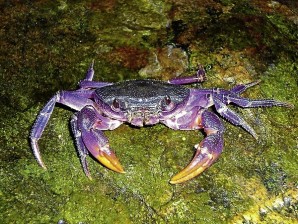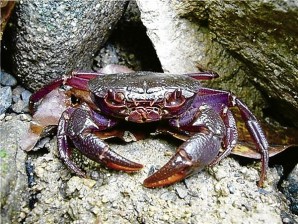Crabs show rich Palawan biodiversity

NEW SPECIES The “Insulamon palawanense” crab is one of the four new species river crustaceans recently discovered by scientists in Palawan. PHOTO CONTRIBUTED BY HENDRIK FREITAG
PUERTO PRINCESA CITY, Philippines—Scientists exploring the inland waters of Palawan have discovered four new species of brightly colored river crabs, underscoring the island’s still unexplored biological richness.
The scientific breakthrough was announced on March 21 by the Senckenberg Research Institute based in Dresden, Germany, which spearheaded several years of biological surveys in various parts of mainland Palawan under the project Aqua Palawana undertaken primarily by De La Salle University (DLSU) in Manila.
Dr. Hendrik Freitag of the DLSU Department of Biology and the Senckenberg Museum of Zoology told the Inquirer in an e-mail interview on Sunday that their study discovered four new species of freshwater crabs under the genus Insulamon, where only one species was previously thought to exist—the Insulamon unicorn—found only in the Calamianes region of Northern Palawan.
Scientific paper
“When the genus was erected, it consisted only of a single species, Insulamon unicorn, which was described from a holotype male from Busuanga Island, and several paratypes from Palawan mainland. Based on available new material, a total of five species are recognized presently, four of which are new to science,” Freitag said in a scientific paper published by the Raffles Bulletin of Zoology on Feb. 29, 2012.
He named the four new species as Insulamon palawanense, Insulamon magnum, Insulamon johannchristiani and Insulamon porcolum.
Freitag said the specimens used in the study were collected from various parts of Palawan during separate expeditions, the last of which were held in 2007 and 2008.
Mining effluents
At the same time, he expressed concern that the habitats of these newly discovered animals were under threat because of effluents coming from mining projects.
“I am very sure that dumping of mine tailings into rivers will have serious impact on the river ecosystem and organismic communities, such as accumulations of heavy metals, siltation and changes in the river hydraulics,” he said.
Freitag said he hoped the results of their study “will have some impact on the mining debate,” in reference to a push by civil society groups to exclude Palawan from resource extractive mining projects because of its fragile topography and rich biodiversity.

“Insulamon magnum” crab. PHOTO CONTRIBUTED BY HENDRIK FREITAG
Of the new crab species, the paper described the colorful Insulamon palawanense as the most widely distributed species in mainland Palawan while the other three new species may be found only in interisland regions of the province.
The three other species were described to have reddish violet predominant colors and were found only in isolated islands.
Freshwater dependent
“These creatures are unable to spread elsewhere, as they skip the larval stage in seawater and depend on freshwater at all stages of their development. Having been completely separated from their relatives, they have developed their own separate species and genera over tens of thousands of years,” said the online journal Alpha Galileo Foundation, which carried Senckenberg’s official announcement of the breakthrough in its website on March 21.
“The smaller the remaining natural habitat the greater is the risk to endemic fauna and flora. Even minor environmental changes can lead to extinctions. It is all the more important to do research in this region and show that the biodiversity of these islands is unique and worth protecting,” Freitag said.
Biodiversity hot spot
His study described Palawan as one of the world’s “biodiversity hot spots” because of its combined biological richness and the threats the province faced. It noted that nearly half of all mammal species in Palawan were unique to the province and could not be found anywhere else on earth.
“The Philippine island of Palawan is something special. Located between the Sundaic and Philippine region it combines two of the world’s most important biodiversity hot spots,” the foundation said.














